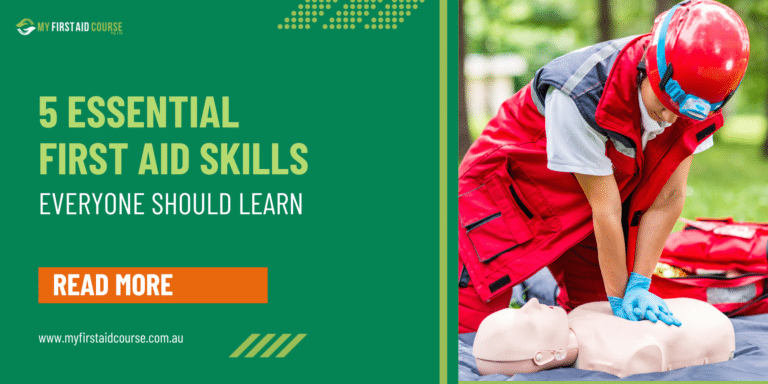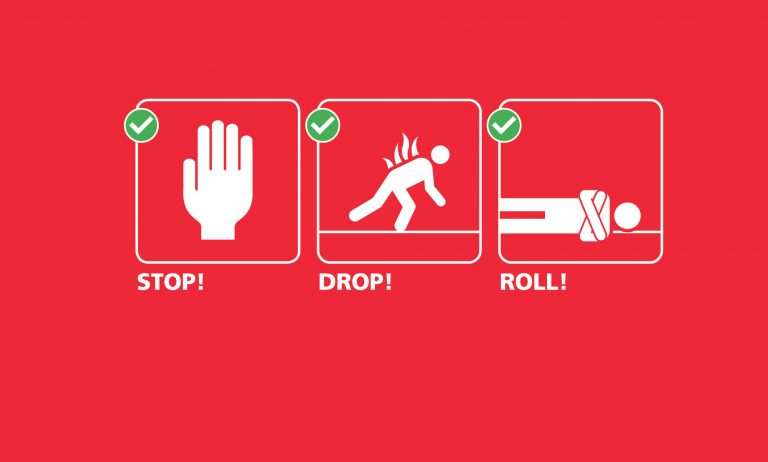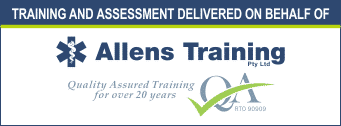Ever found yourself in a situation where basic first aid knowledge could have saved the day? I have. From slicing my finger while enthusiastically chopping vegetables to witnessing a friend faint at a music festival, I’ve learned the hard way that accidents don’t wait for convenient moments.
Let’s face it: first aid can be a matter of life and death. In this blog, we’ll explore essential first aid skills through relatable scenarios. Because nothing says “I’m prepared” quite like knowing how to MacGyver a splint out of a magazine and duct tape during a disastrous company picnic.
So grab your sense of humor and your imaginary first aid kit. We’re about to embark on a journey that might just save a life – or at least make you the hero of your next family barbecue gone wrong.
Before jumping into the details, while you’re reading, consider taking a first aid course, like HLTAID011, Provide First Aid, delivered by myself and other amazing trainers at My First Aid Course, Brisbane. We’ve got you covered to learn the basics in a fun, informative, and efficient way.
Table of Contents
DRSABCD Action Plan: Quick Review

Alright, folks, gather ’round for a crash course in the DRSABCD action plan – your go-to checklist when things go sideways. First up, we’ve got D for Danger. Trust me, you don’t want to become the second victim, so scope out the scene like you’re casing a joint. R is for Response – give ’em a gentle shake and a “Hey, you okay?” If they’re not answering, it’s time to send for help. That’s where S comes in – yell for assistance like you’re calling dibs on the last slice of pizza.
Now, A is for Airway. You’ll want to channel your inner Dracula and tilt their head back to open that airway. B stands for Breathing, so get your ear close and look and listen for breaths like you’re eavesdropping on gossip. If there’s no breath, it’s time for C – CPR. Push hard and fast on the chest like you’re trying to flatten a stubborn pizza dough. Finally, D is for Defibrillation. If there’s an AED around, use it – it’s basically a reset button for the heart, and it’s way easier to use than programming your TV remote.
The DRSABCD action plan is crucial in emergency situations for several reasons:
- Systematic approach: It provides a clear, step-by-step protocol that helps responders remain calm and focused during high-stress situations.
- Prioritization: The plan ensures that the most critical aspects of emergency care are addressed in order of importance, maximizing the chances of survival.
- Safety: By starting with assessing danger, it protects both the responder and the victim from further harm.
- Early intervention: Quick recognition of unresponsiveness and calling for help ensures that professional medical assistance arrives as soon as possible.
- Life-saving actions: The plan includes critical interventions like opening the airway, checking breathing, and starting CPR if necessary, which can be the difference between life and death.
- Universal application: This standardized approach can be applied to a wide range of emergency situations, making it a versatile tool for first responders of all levels.
- Increased survival rates: When performed correctly and promptly, following this action plan significantly improves the victim’s chances of survival and recovery.
- Empowerment: Knowledge of this plan empowers bystanders to take action in emergencies, potentially saving lives before professional help arrives.
Scenario: Deep Laceration to Arm

Imagine you’re at your mate Dave’s house for his infamous annual “DIY and BBQ” day. Everything’s going great until Dave decides to demonstrate his skills with a new power saw. Spoiler alert: Dave is not a ninja.
Here’s how to manage this situation:
- Check for danger: Make sure the area is safe. That means unplugging Dave’s new “toy.”
- Assess the wound: It’s a deep cut, but thankfully not arterial.
- Call 000: Dave’s DIY disaster is going to need professional attention.
- Apply direct pressure: Grab a clean cloth and press firmly on the wound. If blood soaks through, add more layers. Don’t remove the original cloth.
- Elevate the arm: Raise Dave’s arm above his heart.
- Bandage it up: Once the bleeding slows, wrap a bandage firmly around the wound.
- Keep Dave calm: Distract him from his failed attempt at DIY glory.
- Monitor for shock: Keep an eye out for pale, cool, and clammy skin, weakness, or confusion.
Managing a Deep Laceration:
- Assess the severity: Check the depth and location of the cut.
- Control bleeding: Apply firm, direct pressure with a clean cloth or sterile dressing.
- Protect the wound: Once bleeding is controlled, cover with a sterile dressing or clean cloth.
- Seek medical attention: Deep lacerations often require professional medical care, possibly including stitches, to ensure proper healing and prevent infection.
Scenario: Fainting at a Music Festival
Picture this: You’re at a massive outdoor music festival, surrounded by throngs of swaying fans. The sun is blazing, the music is thumping, and suddenly, the guy next to you — let’s call him Zack — starts swaying a little too much. Before you can say “encore,” Zack’s face goes pale, and he drops.
Here’s how to manage this situation:

- Check for danger: Scan the area.
- Call for help: Wave your arms to get a security guard’s attention.
- Create space: Ask the crowd to step back.
- Position Zack: If he’s breathing normally, roll him into the recovery position.
- Elevate the legs: Prop Zack’s feet up.
- Keep him cool: Fan Zack with whatever’s handy.
- Loosen tight clothing: Undo any tight stuff around Zack’s neck or waist.
- Monitor breathing: Keep an eye on Zack’s chest movements.
- Prevent round two: When Zack comes to, keep him down for a few minutes.
- Hydrate: Offer water.
Fainting First Aid:
- Ensure safety: Protect the person from the surrounding crowd and potential hazards.
- Seek help: Alert festival security or medical staff immediately.
- Assess: Check responsiveness and breathing. If abnormal, start CPR and use an AED if available.
- Position: Use the recovery position if unconscious but breathing normally.
- Elevate legs: Raise the legs to promote blood flow to the brain.
- Cool down: In hot environments, help the person cool off.
- Loosen clothing: Remove or loosen any restrictive items.
- Monitor closely: Keep checking their breathing and consciousness level.
- Gradual recovery: Have them sit up slowly when they regain consciousness.
- Hydrate: Offer water when they’re fully alert.
Scenario: Sprained Ankle at Sunday Soccer

Picture this: It’s a lovely Sunday afternoon, and you’re engaged in the weekly neighborhood soccer showdown. Your friend Alex, fueled by dreams of World Cup glory, attempts a maneuver. Unfortunately, Alex’s feet aren’t quite as talented as the imagination, and there’s a stumble, a yelp, and Alex is down on the field clutching an ankle.
Here’s how to manage this situation:
- Call a time-out: Make sure play stops.
- Assess the situation: Ask Alex what happened.
- Help Alex off the field: Guide them to the sidelines.
- RICER to the rescue: Rest, Ice, Compression, Elevation, and Refer for medical review.
- Rest: Game over for Alex.
- Ice: Raid the cooler. A bag of frozen peas would be ideal.
- Compression: If there’s an elastic bandage, wrap the ankle.
- Elevation: Use the soccer ball bags or a folding chair to prop up the injured foot.
- Refer: Encourage Alex to seek medical attention.
- Pain relief: Offer some over-the-counter pain meds if available.
Sprained Ankle First Aid in a Sports Setting:
- Stop activity immediately to prevent further injury.
- Assess the severity: Look for significant swelling, discoloration, or deformity.
- Apply the RICER method promptly:
- Rest: Avoid putting weight on the injured ankle.
- Ice: Apply cold packs for 15-20 minutes every 2-3 hours.
- Compression: Use an elastic bandage, starting from the toes and moving upwards.
- Elevation: Raise the ankle above heart level when possible.
- Refer: Encourage Alex to seek medical attention.
- Pain management: Offer over-the-counter pain relievers if available.
- Follow-up care: Recommend proper rehabilitation to prevent future injuries and ensure full recovery.
Scenario: Heart Attack at the Office

Note: Always take any suspected heart attack seriously and act quickly. Follow official first aid guidelines and the instructions of emergency services.
Picture this: You’re at your desk, slogging through yet another thrilling spreadsheet, when suddenly your colleague, Bob, clutches his chest, goes pale, and looks distressed.
Here’s how to manage this situation:
- Check for danger: Ensure the area is safe.
- Check response: Bob’s awake but clearly not feeling his best.
- Call 000 immediately: Time is of the essence. Tell the operator it’s a suspected heart attack.
- Help Bob get comfortable: Loosen his tie and any tight clothing. Have him sit or lie down.
- Offer aspirin: If Bob’s not allergic and the emergency operator approves, give him a 300mg aspirin to chew slowly.
- Keep Bob calm: Reassure him that help is on the way.
- Monitor and be prepared: Keep a close eye on Bob. If he becomes unresponsive and isn’t breathing normally, you may need to start CPR.
- Clear the area: Politely ask your curious coworkers to give Bob some space.
Signs and Symptoms of a Heart Attack:
- Chest pain or discomfort: Often described as pressure, squeezing, fullness, or pain in the centre of the chest. It may last for more than a few minutes or come and go.
- Upper body discomfort: Pain or discomfort in one or both arms, the back, neck, jaw, or stomach.
- Shortness of breath: This can occur with or without chest discomfort.
- Other signs: These may include breaking out in a cold sweat, nausea, or lightheadedness.
- Women’s symptoms: Women are more likely to experience shortness of breath, nausea/vomiting, and back or jaw pain.
Real Life First Aid Scenario Practice
Emergencies can happen anytime, anywhere. Being prepared with the right skills and knowledge isn’t just smart—it can be the difference between life and death.
That’s where My First Aid Course, Brisbane comes in. We understand that in today’s fast-paced world, time is precious. That’s why our courses are specifically designed for busy individuals who want to get upskilled quickly without compromising on quality.
Our expert instructors provide comprehensive training that equips you with life-saving skills and knowledge, all in a time-efficient format. From CPR to wound care, from recognizing heart attack symptoms to managing severe allergic reactions, we cover it all.
Remember, in an emergency, every second counts. By investing a small amount of time in first aid training now, you’re preparing yourself to act swiftly and confidently when it matters most. Whether it’s helping a colleague, a loved one, or a stranger in need, the skills you learn with us could make you someone’s hero.
Don’t wait for an emergency to wish you knew what to do. Join us at My First Aid Course, Brisbane, and gain the power to save lives. Because when it comes to first aid, being prepared isn’t just an option—it’s a responsibility we all share.






